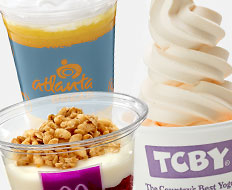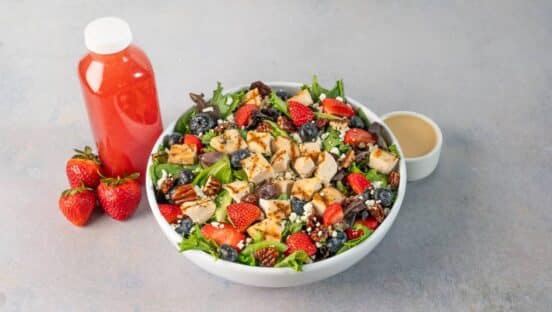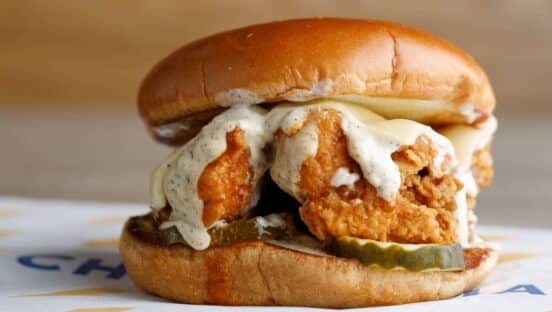Some people may consider the term healthful dessert as a bit of an oxymoron.
Desserts are typically recognized as being indulgent—rich and flavorful—and not necessarily a part of the dining experience that would be considered good for you.
But perception is not always reality, and it’s not necessarily difficult for quick-service restaurants to feature desserts that are nutritious, low in calories, and, yes, even healthy.
“There are actually many good options available at restaurants right now, and new products are being added all the time,” says Kerry Neville, spokeswoman for the American Dietetic Association and a Seattle-based registered dietician.
More than four in five limited-service restaurant chains have desserts on their menus, and a recent survey by Technomic Inc.’s Menu Monitor found that the number of healthier dessert offerings at these companies increased nearly 70 percent over the past two years.
The top dessert items at limited-service units, however, remain pretty traditional. They are cookies, brownies, ice cream, cheesecake, and chocolate cake.
“That’s not a surprise. These are tried and true favorites,” says Maria Caranfa, an analyst for Mintel Menu Insights, which determined the top dessert items. “The first three are portable, which is very important for many customers of these restaurants.”
Adding a healthful dessert item may be as easy as offering fruit, although many diners don’t consider that as a dessert, Neville says. Instead, consumers may be more accepting of fruit as dessert if it is mixed with yogurt, frozen yogurt, or ice cream, or offered with a dip.
“At most places, desserts are cookies, brownies, and cakes that tend to be high in calories and fat and not very nutritious,” says Dr. Julie Kennel Shertzer, director of the dietetic internship program in Ohio State University’s Department of Human Nutrition.
A small serving of low-fat ice cream, however, can provide a diner with 10 percent of his daily calcium requirement. Yogurt is another great source of calcium and other nutrients, while fresh or fresh-frozen fruit can provide various vitamins and minerals.
The easiest way to control calories and fats in desserts is through portion control, according to nutritionists, chefs, and restaurant officials.
“In general, most desserts are Costco-sized,” Neville says. “But a lot of the time, people just want a little dessert, not a huge portion. The problem is that many people will eat what is in front of them, so smaller portions might keep them from going overboard.”
Shertzer uses Wendy’s venerable Frosty dessert as an example. Although a large, 20-ounce original Frosty has 520 calories and 13 grams of total fat, the 6-ounce Junior size has just 150 calories and only 4 grams of fat while providing 15 percent of daily requirements for calcium.
Caranfa says it is important when discussing portion control “that you get a lot of trips to mouth. If you get one cookie for 200 calories, it’s OK, but if there are three smaller cookies that give you the same calorie count, that’s better. The three cookies take longer to eat, so you feel you are getting more for your money.”
Many other quick-service restaurants have had success with low-calorie, tasty desserts.
McDonald’s extensive dessert menu includes a 3.2-ounce vanilla, reduced-fat ice cream cone that has 150 calories and just 3.5 grams of total fat, providing 10 percent of daily calcium requirements. Choose a milkshake or hot fudge sundae, however, and those calorie and fat numbers, even with low-fat ice cream, grow substantially.
The chain also has 7-ounce fruit and yogurt parfaits and apple dippers with caramel dip, both of which contain even fewer calories and fat than the cone.
Cinnamon Twists are the sole dessert option at Taco Bell, and the puffed corn twists have 170 calories with 7 grams of fat. Subway has yogurt as well as apple slices, both with less than 100 calories and no fat, while Sonic Drive-Ins have bananas or apple slices with caramel dip, both with slightly more than 100 calories.
But being low in calories doesn’t necessarily equate to being the most healthful. Depending how a food item is processed, nutrients can be reduced while additives are increased.
“There’s been a lot more food engineering out there during the last few years, sometimes naturally and sometimes not,” says Dino Lambridis, one of the founders of EVOS, a Tampa, Florida–based fast-casual chain that has units in four states.
There has been controversy about the benefits and possible health risks of food additives, which include artificial stabilizers and flavor enhancers.
EVOS focuses on serving healthier food, Lambridis says, and he points to the chain’s milkshakes as a case in point. The restaurants use natural, organic ingredients, including 2 percent milk that contains no hormones or antibiotics, to create 16-ounce shakes that have anywhere from 140 to 230 calories and zero to 2.5 grams of fat.
The regular mango guava shake has no cholesterol, sodium, or fat.
For EVOS, healthful doesn’t necessarily mean low-calorie all the time. The chain’s all-natural chocolate chip and oatmeal cranberry raisin cookies use no artificial ingredients and not even high fructose corn syrup. But they do carry a heftier calorie count.
Lambridis says creating healthier food doesn’t require any special equipment, but it often can mean acquiring better ingredients, which could cost more.
Developing healthful desserts is not difficult from a culinary standpoint, either. Hans Rouillard, a California chef who has worked in both the Disney and Hyatt organizations, says all that’s needed is a little creativity and the ability to make small modifications, such as the baking time in pies or other pastries that use artificial sweeteners instead of sugar.
The problem, he says, is getting customers to try them.
“People inclined to have dessert seem to have a penchant for less-healthy options,” he says. “With dessert being such a small part of the overall menu (8 percent in limited service, according to Technomic), you have to consider the value of making it healthy.”
One company that has focused on providing healthful, nutritious desserts for years is TCBY, the frozen yogurt chain that has more than 400 units in about 20 countries.
Each frozen yogurt serving provides at least 20 percent of the daily calcium and Vitamin D requirements, plus 12 percent of daily fiber and 8 percent of Vitamin A. That doesn’t include the healthful benefits of probiotics, the live microorganisms that are part of active cultures in yogurt. Studies have indicated that probiotics may help prevent infections, lower blood pressure modestly, and boost the immune system.
“The American consumer is understanding the benefits of yogurt, the attributes that make it good for us,” says Michael Ward, president of TCBY, which stands for The Country’s Best Yogurt. “So, with our frozen yogurt, you don’t have to make a choice, as you do with other products. It is good for you and it tastes incredibly good.”
Ward acknowledges there is a large increase in competition from established and new frozen yogurt chains, including Red Mango and Pinkberry, which feature South Korea–style tart frozen yogurt. However, he says that growth reflects the changing—and more healthful—eating habits of Americans.
“The government over the last five years has been trying to educate us as a people that we tend to be overweight, and that child obesity is a huge issue,” he says. “So, consumers are consciously choosing to cut back on fattening treats.”
At Souplantation and Sweet Tomatoes, which are salad- and soup-based buffet restaurants owned by Garden Fresh Restaurant Corp., chocolate and vanilla fat-free frozen yogurt makes it “easy to have a healthy indulgence after a healthy meal,” says Joan Scharff, executive director of brand and menu strategy at the San Diego–based company.
Among the other low-cal dessert items at the restaurants are fat-free puddings, sugar-free gelatins, and sugar-free mousses, including chocolate and raspberry, which have just 40 calories and 3 grams of fat in a half-cup serving.
McDonald’s made regular yogurt mainstream in 2002 when it introduced its Fruit ’n Yogurt Parfait and included it in the $1 menu. The 7-ounce dessert has 130 calories and 2 grams of fat, and the parfait with granola is 30 calories more.
Having healthy, tasty dessert alternatives is important in modern America, says Olivier Arizzi, brand marketing manager with Le Pain Quotidien, which has nearly 50 restaurant/bakeries in five states and Washington, D.C.
“With all the requirements in New York and around the country to make nutritional information more transparent, it forced us to take a closer look at calorie count on the menu,” he says. In addition, “people are so careful about what they eat.”
Le Pain Quotidien rotates low-cal dessert items, including a guilt-free lemon custard with 200 calories and a vegan apple canele that has 220 calories and uses organic ingredients, including apples, soymilk, wheat flour, and agave syrup.
Just as natural ingredients are growing in importance with healthy desserts, they are also key to smoothies, which are marketed as health drinks that can double as a dessert or snack.
A number of chains feature smoothies prominently, including Jamba Juice, Planet Smoothie, Robeks, and Smoothie King. Smoothies are also available at many frozen yogurt stores and in restaurants such as Atlanta Bread, Panera Bread, and Sonic.
“There are a wide range of options, and the nutritional value depends on how the establishment is creating a smoothie,” dietician Shertzer says. “Sometimes it is just sugar, syrup, and either milk or yogurt. Other places will take real fruit, using fresh fruit or 100 percent fruit juice. There is a huge difference in the amount of nutritional value.”











